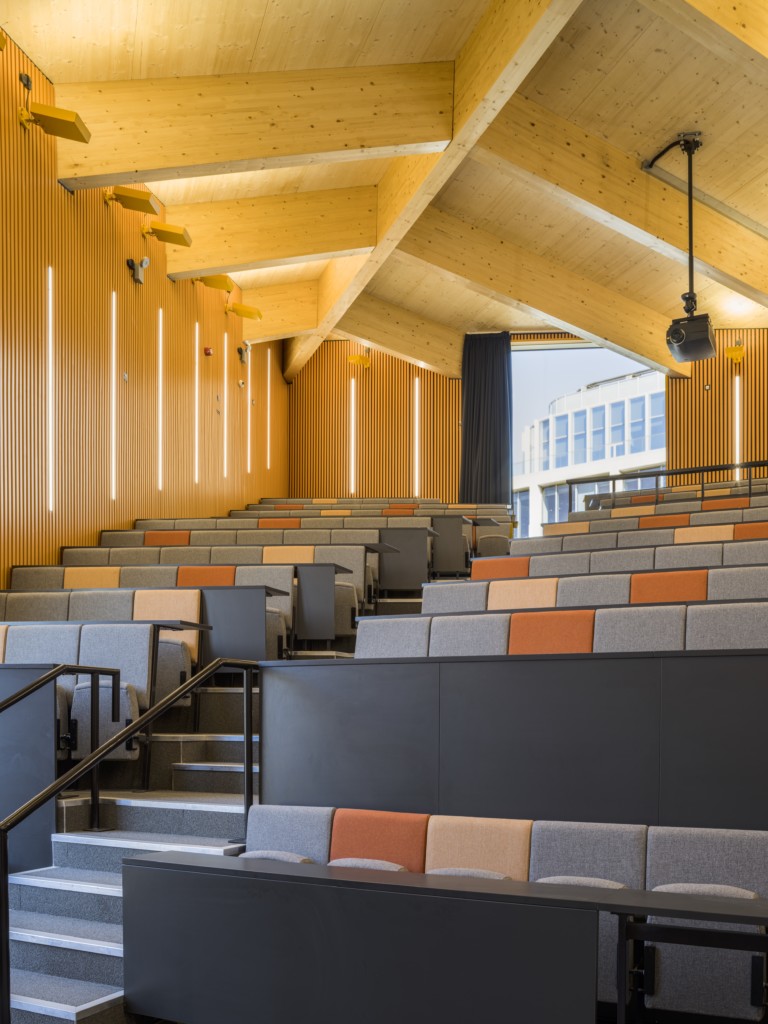![]() On Monday 12th December, Rebecca Rees led our latest Procurement group meeting, to which she invited the winners of the Value category at the Constructing Excellence National Awards 2023. Scott Parkes from the Elephant Rock project (small project winner) and Simon Cash, from the Birkbeck University project (large project winner), joined us to talk about how they secured a win at the awards and the consideration they gave to ‘value’ whilst completing their projects.
On Monday 12th December, Rebecca Rees led our latest Procurement group meeting, to which she invited the winners of the Value category at the Constructing Excellence National Awards 2023. Scott Parkes from the Elephant Rock project (small project winner) and Simon Cash, from the Birkbeck University project (large project winner), joined us to talk about how they secured a win at the awards and the consideration they gave to ‘value’ whilst completing their projects.
Elephant Rock

Scott Parkes spoke to us about the 3 strands of value that ran through the whole of the Elephant Rock project: ecological, social and financial.
Ecological
The site for this project was tight, in terms of its location, due to the close proximity to the coast, a culturally important listed building and wintering birds that use the area. This meant that the planning phase of the project was of high importance to ensure the building was constructed sympathetically to its surroundings.
One of the most important adjustments that was made in consideration of the area was delaying the construction start date and condensing the length of the build. This enabled them to have as little impact as possible on the local wildlife, particularly the wintering birds.
Social
In order to engage the local community and maintain strong links, Seymour Civil Engineering were brought in, as a local contractor, to help deliver the project. Due to this company’s local nature, many of the employees on the project were themselves local citizens.
Local schools were also invited to come and visit the site to see the project unfold and help to give the children a better sense of what this building would be. Encouraging these visits enabled further links to community and started to foster a sense of ownership towards the project for those that visited to share with others.

Upon completion, this project was handed back to the local community and is even now driven by the needs and wants of the locals, including what events are run there. The project supported in the Love Hartlepool campaign and has worked to develop pride, amongst local people, for the area in which they live.
Financial
This project was a financial success in that it came in under budget and on time. When planning the project, the whole life costing was considered which enabled the design of a low maintenance building that would not require much money to upkeep.
Birkbeck University
The primary aspects of value for this project were financial, to see a return on the investment made, and social, to create a space to inspire and engage students. On top of these priorities, further consideration was given to sustainability. 
Financial
Planning of this project took a considerate amount of time (approximately 3 years) in order to decide whether the building should be developed using it’s current form or knocked down to rebuild on the site. This decision-making process needed to be carefully thought through as there were other factors to consider, such as how knocking down the building would sit with the company’s sustainability principles and what building restrictions would be in place from the local authority.
In the end it was decided that the building would be stripped back to its core and then the space would be revitalised and maximised.
Social
At its heart, this project was a space for education, however, the aim was to also provide space that would benefit the community. The building is now hireable for external use but also houses education spaces and meeting rooms to ensure complete functionality for students. These collaborative areas in particular offer great value to those completing their studies and are one of the most widely used resources in the building.
Birkbeck University recognise the value they have achieved via this project and plan to replicate the process in future builds.

Sustainability
The materials that were used in this project were chosen to be sensitive to the environment such as the cross laminated timber building extension which is lightweight and has a low impact on the structure. The timber frame used to accommodate this is more sustainable than other methods that were considered and was chosen for this reason.
Learning from these projects
Communication is key:

Both projects have highlighted the importance of setting out their value principles in the initial planning phase and articulating these clearly with all parties involved. The inclusion of specific measures and outcomes ensures that the success criteria can be understood by all.
Elephant Rock was able to do this successfully due to pre-existing good relationships with the supply chain and local contractors which meant everybody knew what was expected.
Birkbeck University took part in regular meetings in which all parties came together to ensure the project was on track and that the values and principles remained high priority for all involved. This was helped by having a proactive client who worked hard to establish open communication and collaboration.
The design phase should be given adequate time:
Ensuring the design phase is given sufficient time allows for any issues to be spotted and rectified  and enables for proper consideration of how the building will successfully deliver the value principles outlined. Both projects ensured that their aims were iterated from the very beginning and were high priority in the
and enables for proper consideration of how the building will successfully deliver the value principles outlined. Both projects ensured that their aims were iterated from the very beginning and were high priority in the
design process.
This effectively demonstrates some of the guidance from the Construction Playbook and Value Toolkit which both outline the need for the effective design of a project. Doing so supports better procurement, engagement of the supply chain, achievement of aims and value principles, etc.
Consideration of the Project’s Whole Life Cycle:
Both of these winning projects show how important it is to look at the whole life cycle of a build rather than just the construction phase. These projects do not just stop upon the completion of the building and monitoring and measuring should continue beyond this point.
just the construction phase. These projects do not just stop upon the completion of the building and monitoring and measuring should continue beyond this point.
Group Discussion Around Value Toolkit
Benefits of the Value Toolkit
It does not just focus on one facet of value but brings together all threads into one place. This ensures that all aspects are considered when partaking in a build project and leaves no room for areas to be left out because they are deemed less important or don’t fit into the plan.
The Toolkit gives a consistent approach to assessing the value a project will offer and sets out standards, policies and outlines for everyone to follow. However, there is room for unpicking it slightly to make it less scary for smaller organisations and to enable people on day-to-day projects to understand how to implement it.
The Value Toolkit supports some of the key targets for the construction sector currently e.g. sustainability and Net Zero, keeping costs down in the current climate, etc. It would be beneficial for local authorities to begin to make wider use of the Toolkit to in hopes that this would filter down.
We should seek to build on the work that Constructing Excellence has done on Comparing Value Across England and Wales.


Current Challenges for the Value Toolkit
It is evident how the Toolkit can be applied well on larger projects but its use on smaller projects needs further exploration. The group are keen to explore how that can be applied on smaller projects with less client and design resource to deploy.
SMEs will benefit from a better understanding of the Toolkit as well as more effective communication around Value in order for projects to begin to match with SMEs that will best be able to support their value principles.
There needs to be less focus on ‘cheaper is better’ and organisations need to remember that value will be more than cost. Trying to procure in the cheapest way possible will not enable for the most value to be added, sometimes more needs to be put into a project to gain the best outcomes.
When completing projects, consideration is not always given to the whole life cycle of the project. By only focusing on the construction, practical completion and handover, value may be lost in the operational phase, e.g. if a project costs too much to maintain upon completion, it is losing value.
Discussion Around Whether the Wider Definition of Value is Support by Digital
Current BIM models are not accurate enough to underpin procurement, but more informed BIM is an aspiration as it could be very useful as an enabler.
A more standardised approach to BIM models is needed to really see the benefits of technology as an enabler. The problem with this is that BIM models aren’t always used for the same purpose, it is not necessarily as ‘one size fits all approach’. The quality of data collected is largely dependent on the data that is needed.
Different technology and data models need to be able to communicate with each other. For example, there are technologies being used in refurbishment and retrofit to gather data about buildings that is needed to make informed design and planning decisions. These technologies are not currently compatible with BIM but there is a general consensus that we are getting nearer to this point.
For example, there are technologies being used in refurbishment and retrofit to gather data about buildings that is needed to make informed design and planning decisions. These technologies are not currently compatible with BIM but there is a general consensus that we are getting nearer to this point.
The Construction Playbook speaks of ‘digitisation harmony’ and this is where we need to get to. Technology should drive progress forward, but it can only do this if we are able to use the data collected to serve a purpose.
Outputs and Next Steps for the Procurement Group
The group aim to put together pointers for how procurement can enable value. This should include:
- communication with the whole supply chain
- the need for a value plan
- data and its importance
- appreciation of value vs. how much things cost
- importance of timing- procurement must be considered early (often earlier than people realise)



